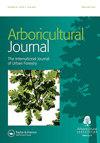信
Q3 Agricultural and Biological Sciences
引用次数: 0
摘要
先生,我很感激有机会回复马克·切斯特和乔恩·赫奇博士的来信。我谨代表CAVAT行政人员这样做。首先,在进入任何细节之前,我认为建立CAVAT和树木与景观评估师委员会(CTLA)方法之间的关键区别将会有所帮助。CAVAT起源于1997年在米尔顿凯恩斯举行的树木估价会议上,作者、当时的主席乔纳森·哈泽尔(Jonathan Hazell)和树木委员会的乔恩·斯托克斯(Jon Stokes)之间的一次对话。我们一致认为,英国树木栽培需要一个像美国树木和景观评估师委员会(CTLA)方法一样强大和有效的树木评估系统。这一需求引导了CAVAT的发展至今。CAVAT和CTLA树干公式方法都是外推的,折旧成本重置法(DRC)适用于美化树木。然而,CTLA方法只关注补偿,具有房地产估值背景,CAVAT旨在表达树的资产价值,具有多种目的,包括但不限于补偿价值。同样重要的是,CAVAT使用的舒适性并非仅限于“树木不是作为作物种植”,而是在树木作为公共设施的框架内,正如1991年《城乡规划法》第197和198条所规定的那样,以及最近在《国家规划政策框架》第170 (b)段中明确规定的那样,树木是自然资本。CAVAT的主要目的是使城市树木作为资产进行管理,这是城市林业的基本要素。出于好奇,基于CAVAT的早期版本,可以在案例研究9:建立和证明城镇树木预算II (Britt和Johnson, 2008)中找到如何将该理论付诸实践的表达。我们论文的案例研究2(即Doick等人(2018)的论文,以下简称“论文”)中给出了这一雄心壮志的当前示例,现已付诸实践。它阐述了伦敦自治市镇如何采用CAVAT作为基于资产的高速公路树木管理方法的一部分,以及随之而来的好处。首先转到Mark Chester的信,在对论文作者进行了简短的赞扬之后,他继续论证CAVAT的使用是不必要的,或者至少几乎重复了CTLA方法中可用的和更好的表达。这与UKI - RPA指导说明1有些不一致,该说明1向英国介绍了CTLA方法,包括Heuch博士在内的联合作者将其与现有方法放在一起。他继续质疑没有提及“ATA”;这是《植物鉴定指南》第九版(CTLA 2000)中解释的“调整主干面积公式”的缩写。这是利用树干公式法对直径超过75厘米的树木进行系统限制的方法。理由如下:“就像房地产估值的许多方面一样,树木达到了树木学杂志2020年第42卷第1期。1,56 - 60 https://doi.org/10.1080/03071375.2020.1725342本文章由计算机程序翻译,如有差异,请以英文原文为准。
Letter
Sir, I am grateful for the opportunity to respond to the letters from Mark Chester and Dr Jon Heuch. I do so on behalf of the CAVAT Executive. Firstly, before getting into any details, I feel it will be helpful to establish the key distinctions between CAVAT and the Council of Tree and Landscape Appraisers (CTLA) methods. CAVAT has its origin in a single conversation at the Arboricultural Association conference on tree valuation in Milton Keynes in 1997, between the writer, the chairman for the day Jonathan Hazell and Jon Stokes of the Tree Council. We agreed that UK arboriculture needed a system for tree valuation as robust and effective as the Council of Tree and Landscape Appraisers (CTLA) methods were in the USA. That need has guided the development of CAVAT to the present day. Both CAVAT and the CTLA trunk formula method are extrapolated and depreciated cost replacement methods (DRC) intended for amenity trees. However, while the CTLA methods focus solely on compensation, with a background in real estate valuation, CAVAT is designed to express a tree’s asset value, with multiple purposes including but not limited to compensation value. Equally significantly CAVAT uses amenity not with the limited meaning of “trees not grown as a crop” but within the framework of the trees as public amenities, as established in the Town and Country Planning Act 1991, sections 197 and 198, and more recently in the National Planning Policy Framework at paragraph 170 (b) which specifically establishes trees as natural capital. CAVAT’s main aim is to enable the management of urban trees as assets, an essential element of urban forestry. For the curious, an expression of how that theory should be put into practice, based on an early version of CAVAT, may be found in Case Study 9: Establishing and Justifying the Tree Budget in Trees in Towns II (Britt and Johnson, 2008). A current example of that ambition, now put into practice, is given in Case Study 2 of our paper (namely the Doick et al. (2018) paper, hereafter referred to as “the paper”). It sets out how a London borough adopted CAVAT as part of an asset-based approach to highway tree management and the benefits that followed. Turning to the letter from Mark Chester first, having begun with a brief compliment to the authors of the paper he moves on to argue that use of CAVAT is unnecessary or at least nearly duplicates what is available and better expressed in the CTLA methods. This is somewhat at odds with the UKI – RPA Guidance Note 1, which introduced the CTLA methods to the UK, where the joint authors, including Dr Heuch, position it alongside existing methods. He continues by questioning the absence of reference to “ATA”; the acronym stands for the Adjusted Trunk Area formula, explained in the Guide for Plant Appraisal ninth edition (CTLA 2000). It is the means by which valuations using the trunk formula method are systematically limited for trees with a diameter exceeding 75 cm. The rationale is stated: “like many aspects of real-estate valuation trees reach an Arboricultural Journal 2020, VOL. 42, NO. 1, 56–60 https://doi.org/10.1080/03071375.2020.1725342
求助全文
通过发布文献求助,成功后即可免费获取论文全文。
去求助
来源期刊

Arboricultural Journal
Agricultural and Biological Sciences-Agronomy and Crop Science
CiteScore
2.40
自引率
0.00%
发文量
28
期刊介绍:
The Arboricultural Journal is published and issued free to members* of the Arboricultural Association. It contains valuable technical, research and scientific information about all aspects of arboriculture.
 求助内容:
求助内容: 应助结果提醒方式:
应助结果提醒方式:


